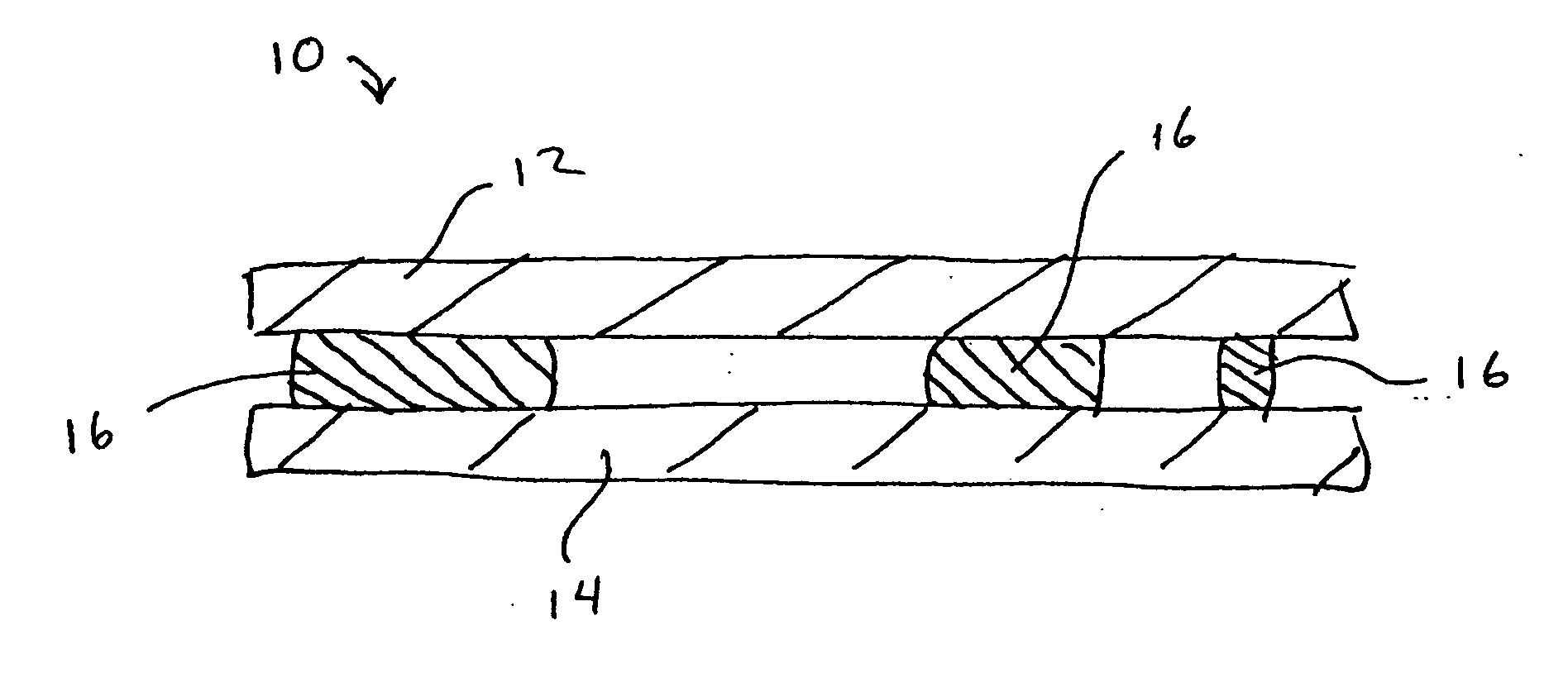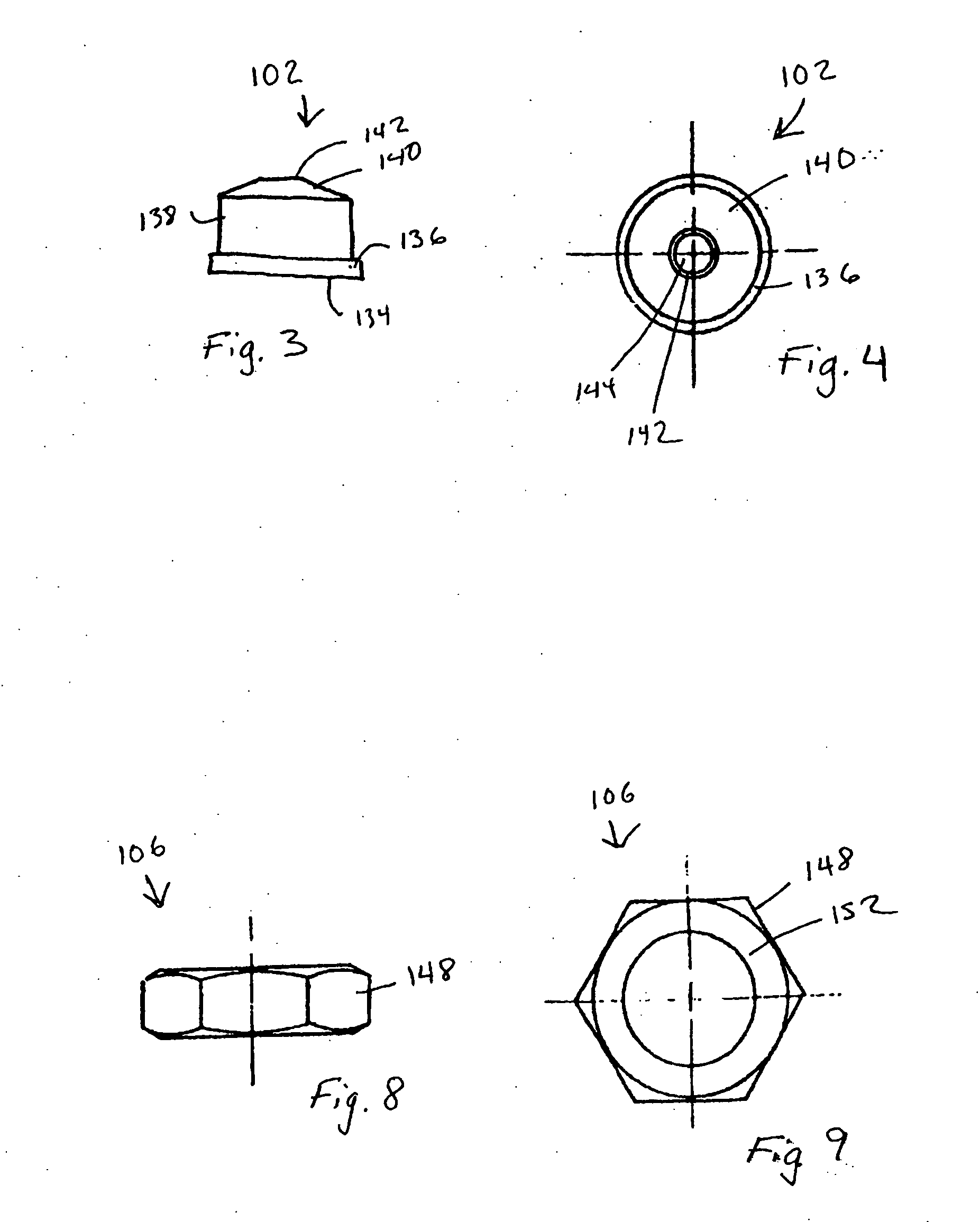Paper laminates manufactured using foamed adhesive systems
a technology of adhesive system and paper laminate, which is applied in the field of tissue paper laminate, can solve the problems of damage, tear, or otherwise degrade tissue material, and achieve the effects of low dispense pressure, reliable, and simple manufacturing process
- Summary
- Abstract
- Description
- Claims
- Application Information
AI Technical Summary
Benefits of technology
Problems solved by technology
Method used
Image
Examples
example 1
[0098] An adhesive product is formed by dissolving 100 g Celvol 523 TM polyvinyl alcohol in 878 g of hot water. After cooling, the solution is blended with 12 g of polypropylene glycol and 10 g of a foaming agent (Niaproof Anionic Surfactant 4™). Alternatively, glycerin (or glycerol) may be added to the product or used in lieu of polypropylene glycol. During use, the product is pumped from a tank into the chamber of a nozzle described in FIGS. 2-10 at approximately 5 psig (34.5 kPa), where it impacts a flow of pressurized air (approximately 5 psig (34.5 kPa)) and foams inside the nozzle. The foam is then sprayed onto a tissue web from the nozzle on demand. The web is matted with another web to form a double-ply laminate, which is wound into a roll.
[0099] The plybond strength of this double-ply laminate is expected to be 0.8 gf / in (0.31 gf / cm) for an applied coat weight of 4 mg / ft / in (0.520 g / m2). The plybond strength is the peel strength or average load per unit width of bond requi...
example 2
[0102] An adhesive product is formed by dissolving 100 g Kuraray Poval PVA 205™ (alternatively Celvol 205™ PVA can be used) in 886 g of hot water containing 1.0 g boric, 1.5 g citric, and acid 15 g synthetic layered silicate containing an inorganic polyphosphate peptiser. After cooling, the solution is blended with 5 g glycerin (or glycerol) and 1 g foaming agent (Niaproof Anionic Surfactant 4™). Alternatively, polypropylene glycol may be added to the product or used in lieu of glycerin (or glycerol). 1-5 g of sodium nitrite is also added to the system. Sodium tripolyphosphate can be used in lieu of, or in combination with sodium nitrite. The viscosity of the product was then adjusted to a value below 500 cp by adding water. During use, the product is pumped from a tank into a chamber of a nozzle according to FIGS. 2-10, where it mixingly interacts with air under conditions such that the chamber has an excess volume to allow foam formation, which then is available for application on...
example 3
[0104] An adhesive product is created by dissolving 40 g of Chang Chun BP-24™ in 957 g of hot water with or without citric and boric acids. After cooling the solution is blended with 5 g of glycerin (or glycerol) and 1 g foaming agent (Niaproof Anionic Surfactant 4™). Alternatively, polypropylene glycol is added to the product or used in lieu of glycerin (or glycerol). A small amount 0.1 g to 5 g of sodium nitrite is also added to the system. During use, the product is pumped from a tank into the chamber of a nozzle, where it collidingly intermixes in the chamber with air to form a foamed adhesive. The foam is then sprayed onto a tissue web, the tissue immediately matted with another web to form a double-ply laminate, and then wound into a roll.
[0105] The plybond strength of this double-ply laminate are expected to be 2-2.5 gf / in (0.8-1 gf / cm). The adhesive strikethrough is expected to be light.
[0106] Alternatively, the foam is sprayed onto a nonwoven web that is not tissue and bo...
PUM
| Property | Measurement | Unit |
|---|---|---|
| pressure | aaaaa | aaaaa |
| size | aaaaa | aaaaa |
| temperature | aaaaa | aaaaa |
Abstract
Description
Claims
Application Information
 Login to View More
Login to View More - R&D
- Intellectual Property
- Life Sciences
- Materials
- Tech Scout
- Unparalleled Data Quality
- Higher Quality Content
- 60% Fewer Hallucinations
Browse by: Latest US Patents, China's latest patents, Technical Efficacy Thesaurus, Application Domain, Technology Topic, Popular Technical Reports.
© 2025 PatSnap. All rights reserved.Legal|Privacy policy|Modern Slavery Act Transparency Statement|Sitemap|About US| Contact US: help@patsnap.com



